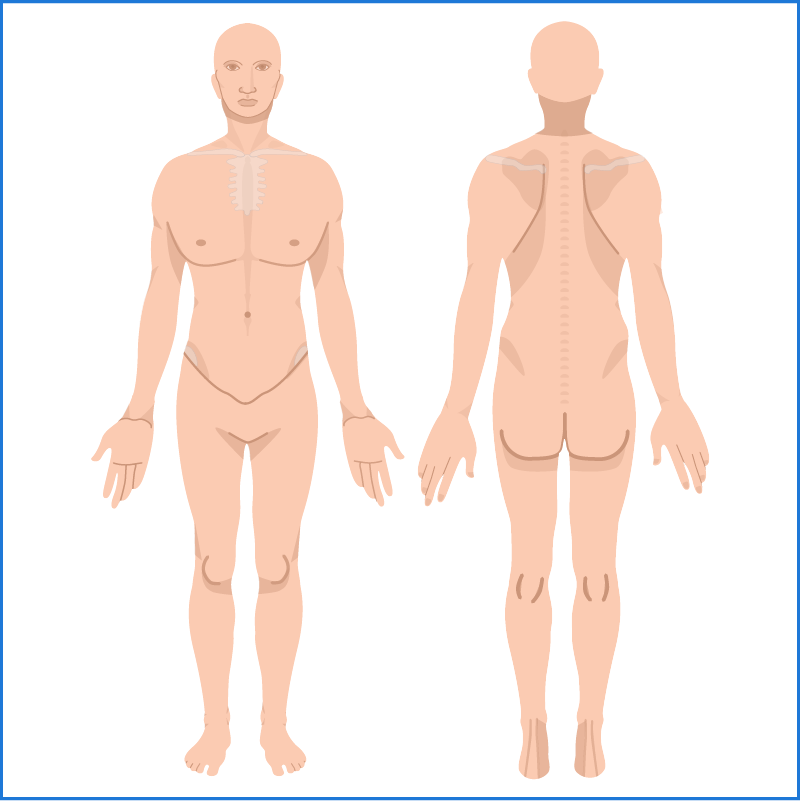6 Assessment Strategies for Chronic Pain and Central Sensitization

Chronic pain is a serious problem, affecting as many as 40 percent of Americans at some point in their lives.1 But where does pain really exist in the body? Is it in the location of the injury or stress, or is it located in the brain? How do body schema, left/right discrimination, localization, and body dysmorphia relate to chronic pain symptoms? And how does knowing these relationships impact your ability to ease the symptoms of chronic pain?
Where Pain and Brain Function Meet
Dr. Adriaan Louw makes a compelling case for the intersection between brain function and pain in his MedBridge course, “A Clinical Application of Easing Pain via Neuroplasticity.” Evidence suggests that the restoration of normal cortical functions, as related to various sensory and motor representations, can significantly reduce pain.2 Factors related to increased pain, however, include a hypersensitive neurological system, fear of movement and pain, disassociation from body parts, reduced laterality and localization, and increased size perception and neural representation of a corresponding painful limb or area.3
Let’s examine potential problems that can be addressed with neuroplasticity, assessments used to identify those problems, and the treatment process.
Potential Problems
Any of the following problems indicate that your patient could be a candidate for neuroplasticity treatment.
- Allodynia—a pain response to non-painful stimuli
- Hyperalgesia—an extreme response to mildly painful stimuli
- Central sensitization—disproportionate aggravating and easing factors, diffuse palpation tenderness, and psychosocial issues such as fear/avoidance, catastrophizing, and depression
- Spreading pain—an area of pain that moves beyond the injured area
Your patient might also experience altered body schema, including:
- Left/right discrimination
- “Missing” body parts
- Altered size of painful area

Body Chart
6 Sensitization Assessment Options
The next step is to complete an appropriate evaluation for central sensitization:
- Complete sensory and range-of-motion assessments and note the pain responses to stimuli that would typically be considered non-painful or only mildly painful, for example tactile and stretch stimuli.
- Interview the client to assess for symptoms and clusters that match with central sensitization.
- Have the client complete the Central Sensitization Inventory.4
- Ask the client to complete a body chart indicating where the pain is in the body. Look for “smudging” in which the area is diffuse and non-specific.
- Show images of right and left body parts (the neck, back, hands, and feet) to assess accuracy of laterality. Accuracy below 80 percent indicates a problem.
- Complete two-point discrimination and localization sensory testing as these relate to intact or impaired cortical maps and motor control.
Unlock your free Central Sensitization Inventory handout!
Email could not be subscribed.
Thank you for signing up!
Treatment Process
Once central sensitization has been established, the following sequence can ease symptoms of chronic pain:
- Provide neuroscience education to the client about pain and pain perception.
- Complete graded motor imagery to train lateralization, localization, and sensory discrimination.
- Use mirror therapy to calm the neurological system and promote movement.
- Focus on traditional therapy that includes range of motion, strengthening, and motor control.
For more about assessing and treating chronic pain, including case examples and video instruction, check out Dr. Louw’s other courses discussing the relationship between the neurological system and pain.
- Dahlhamer, J., Lucas, J., Zelaya, C., Nahin, R., Mackey, S., DeBar, L., Kerns, R., et. al. (2018). Prevalence of chronic pain and high-impact chronic pain among adults—United States, 2016. Morbidity and Mortality Weekly Report, 67(36): 1001-1006.
- Bushnell, M. C., Čeko, M., & Low, L. A. (2013). Cognitive and emotional control of pain and its disruption in chronic pain. Nature Reviews Neuroscience, 14(7): 502-511.
- Lewis, J. & McCabe, M. S. (2015). Body perception disturbance (BDP) in CRPS. Practical Pain Management, 10(3).
- Nishigami, T., Tanaka, K., Mibu, A., Manfuku, M., Yono, S., & Tanabe, A. (2018). Development and psychometric properties of short form of central sensitization inventory in participants with musculoskeletal pain: a cross-sectional study. PLoS ONE, 13(7): e0200152.

